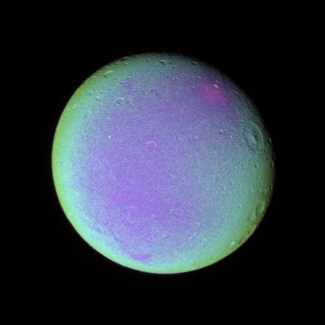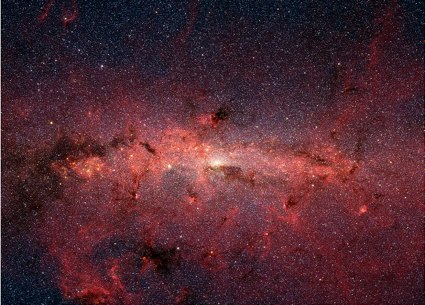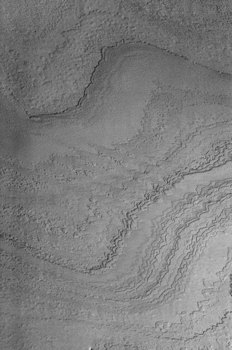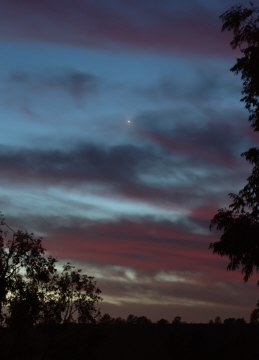2006 Space and Astronomy News
2006 February 25
Pleiades Occultations
(FEB 3) Chances are you have noticed the faint, close grouping of stars known as the Pleiades glittering in the winter sky. This Sunday night–Monday morning (February 5–6), the first quarter Moon passes through the Pleiades for observers on the West Coast and Hawaii.
Using a small telescope or binoculars, skywatchers can watch the Moon eclipse (or, as astronomers call it, "occult" from Latin "to hide") members of the star cluster. Whether the Moon occults a given star, as well as the disappearance and reappearance times, varies depending on location.
From downtown Los Angeles, the stars Merope, Alcyone, Atlas, and Pleione disappear at 00:16, 00:56, 01:30, and 01:36 PST (08:16, 08:56, 09:30, and 09:36 UTC), respectively. The reappearances of Merope and Alcyone will be difficult to see due to the Moon"s low elevation and because they emerge on the Moon"s daylight side. Pleione and Atlas reappear after moonset.
For the disappearance and reappearance times of the brightest Pleiades for other cities, use the following links:
www.lunar-occultations.com/iota/2006plnam/0206zc537.htm
www.lunar-occultations.com/iota/2006plnam/0206zc552.htm
www.lunar-occultations.com/iota/2006plnam/0206zc560.htm
www.lunar-occultations.com/iota/2006plnam/0206zc561.htm
Of particular interest is the gazing occultation of Electra. The Moon will barely occult or graze the star within an extremely narrow zone that runs through southern California. Suitably equipped observers within the path may be able to alternately see the star disappear behind mountains and shine through valleys on the Moon"s north pole.
Occultation enthusiasts have identified northern Somis, California as a prime location for observing the graze. The narrow path also passes over Thousand Oaks, part of Los Angeles, and northern Orange County, as well as other locations from south of Santa Maria to the southern Imperial Valley.
Detailed maps, information about a planned expedition to northeastern Orange County, and other information is available at iota.jhuapl.edu/plds6feb.htm.
Center Dedicated to Save Meteorites
(FEB 1) The world"s meteorites are vanishing and could be gone in a lifetime. To preserve these scientific treasures, a University of Arizona scientist and private collector have formed the UA Southwest Meteorite Center. More
Dione in False Color

This recently released false color Cassini image reveals subtle differences in the leading hemisphere of Saturn"s moon Dione. The reason for the color variations is unknown, but may be due to differences in surface composition or soil grain size. JPL manages the Cassini mission for NASA"s Science Mission Directorate. Photo courtesy of NASA/JPL/Space Science Institute.
SuitSat
(JAN 26) The crew of the International Space Station will soon cast an empty space suit adrift to test a new concept. Signals from SuitSat should be audible on the ground using a simple police scanner or 2–meter ham radio gear. More
Solar Physicists Report Paradox
(JAN 23) Less sunlight reaching the Earth"s surface has not translated into cooler temperatures, according to a team of solar physicists at New Jersey Institute of Technology (NJIT). More
Waiting For Launch

A Falcon I rocket stands on its pad at Omelek Island in the Central Pacific. California-based Space Development Corporation hopes to launch the vehicle next next month. The launch will be the first-ever for the Falcon I series of low-cost rockets. Photo courtesy of Space Development Corp.
3,2,1 ... Blastoff! Vandenberg Preps for Another Year of Flawless Launches
(JAN 18) VANDENBERG AIR FORCE BASE, Calif. - The 2006 launch schedule for Vandenberg is looking to be the busiest in six years, with twice the launches planned as last year, according to the 30th Space Wing Plans office. More
Sky Survey Tops 2005 Discoveries
(JAN 17) When it comes to finding asteroids or comets that swing too close to home, the Catalina Sky Survey is currently Earth"s best defense. More
Peering into the Core

This dazzling infrared image from NASA"s Spitzer Space Telescope shows hundreds of thousands of stars crowded into the swirling core of our spiral Milky Way galaxy. In visible-light pictures, this region cannot be seen at all because dust lying between Earth and the galactic center blocks our view. The Spitzer Space Telescope mission is managed by the Jet Propulsion Laboratory. Image courtesy of NASA/JPL-Caltech/S. Stolovy (SSC/Caltech)
Dual Shadow Transit
(JAN 14) The endless dance of Jupiter"s moons will treat observers to a dual shadow transit this Monday morning. On January 16 from 05:54 to 07:52 PST (13:54 to 15:45 UTC), Europa and Ganymede will cast ink-black shadows into the giant planet"s atmosphere. The shadows and their movement across Jupiter"s disk should be easily visible in telescopes with apertures as small as four or five inches.
Search for Interstellar Dust
(JAN 10) The Planetary Society, the founding sponsor of SETI@home, is again teaming with the University of California at Berkeley to engage the public in real science. The new project - Stardust@home - will allow internet users to help researchers search for microscopic interstellar dust particles captured by NASA"s Stardust spacecraft, scheduled to return its fragile cargo to Earth on January 15, 2006. More
Polar Layers

Layered terrain near Mars" south pole was captured in this view from NASA"s Mars Odyssey spacecraft"s THEMIS instrument. The image has a resolution of 52 feet (17 meters). Image courtesy of NASA/JPL/Arizona State University
Dual Moon Transit
(JAN 7) Observers on the West Coast have an opportunity to see a dual jovian moon transit this Monday. On January 9 from 06:33 to 07:45 PST (14:33 to 15:45 UTC), Jupiter"s moons Europa and Ganymede will pass in front of the planet"s disk. Assuming good conditions, the event should be visible before sunrise in a moderate-sized amateur telescope.
Advanced Instrument Delivered
(JAN 5) AZUSA, Calif. - Northrop Grumman Corporation (has delivered the first Advanced Technology Microwave Sounder (ATMS) to the National Aeronautics and Space Administration (NASA) for early integration into a new spacecraft, for the NPOESS Preparatory Program (NPP), to be launched in early 2008 to monitor global environmental conditions. More
Last Look

Venus shines between bands of clouds from an approaching storm Friday evening. The planet is currently making a rapid transition from the dawn to dusk sky, but the event is being obscured by extensive cloudcover from a pair of winter storms. Copyright 2005, Brian Webb
لیست کل یادداشت های این وبلاگ
